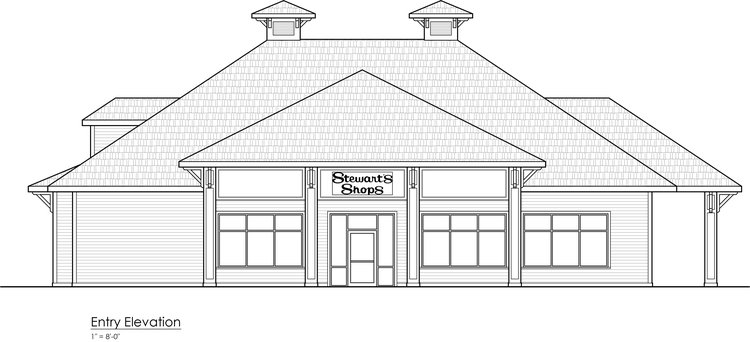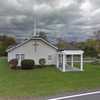Villagers submit their own plans for Stewart's shop
— From Stewart’s Shops
In its May filing with the village, Stewart’s included architectural detail updates and replacements for its proposed Altamont Boulevard project like swapping out the stacked stone for brick on both the building’s veneer and on the freestanding sign, and adding molding window dormers in front of the building and gable ends of the roof.
ALTAMONT — A group of village residents, concerned the Stewart’s proposal for a new shop will clash with Altamont’s historic character, has submitted its own architectural drawing.
The Altamont Planning Board at its April meeting extended the public hearing on Stewart’s Shops special-use permit application and site-plan approval for its proposed Altamont Boulevard project, giving the company until May 4 to submit answers to questions from residents and from the planning board. The public has until May 11 to examine Stewart’s latest filings, which are available on the village’s website.
The next planning board meeting is scheduled for May 18.
Stewart’s is seeking to replace its current 2,700-square-foot store with a 3,340-square-foot shop, which would involve tearing down a company-owned home at 107-109 Helderberg Ave. The village’s zoning board in March approved three variances the company needed for the project to move forward.
If approved, it would take Stewart’s approximately 14 weeks to complete the project.
“Many people believe the process for approving Stewart’s expansion has already gone on too long; some believe that the decisions were all made when the zoning variances were granted. However, I believe the appropriate time to decide most aspects of Stewart’s proposed expansion is now, during the site-plan approval process,” resident Fran Porter wrote in submitted remarks to the planning board for the April 27 virtual public hearing.
Porter continued, “Though some of the same points that will be made to the Planning Board have been raised before other Village Boards, the Planning Board has the unique authority and the duty to approve the site plan ….”
Porter said that the size of the proposed building, including square footage and height; lot configuration; landscaping; signage; and lighting still have to be signed off on by the planning board.
Planning board member Connie Rue brought up the idea of using nearby historical properties as architectural models for the new store. “To soften the look a little so it wasn’t so … plain, [although] that’s not quite the right word,” Rue said.
Stewart’s May filing with the village included architectural detail updates and replacements like swapping out the stacked stone for brick on both the building’s veneer and on the freestanding sign; molding has been added to window dormers in front of the building and gable ends of the roof; and brackets have been added where the porch columns meet the roof.
Some have even taken it upon themselves to submit their own architectural drawings for what they think a new Altamont Stewart’s should look like.
Described by Altamont resident and Albany County Legislator Jeff Perlee as a group of village residents concerned about the character of the village in addition to a few commercial property owners who were obliged to follow existing zoning in order to make their projects fit in with the village, this group submitted an Altamont-appropriate design to the planning board this week for its review.
Chuck Marshall, a real-estate representative for Stewart’s, told The Enterprise of the design from Perlee’s group, “We will look at it as part of every other thing that we receive from the public.”

A group of Altamont residents and property owners have submitted a Stewart’s Shop design to the planning board that they feel is more appropriate for the village.
Perlee for the most part is in support of the project, but he takes issue with its architecture. As someone who owns and has renovated several commercial buildings with his partners in Altamont, Perlee told The Enterprise in an email, “We took pains to make sure the design and plans were consistent with the historic character and integrity of the area.”
As proposed, the Stewart’s project is not compliant with the village code, Perlee said, pointing specifically to chapter 355, section 36E, sub-section (r): “The proposed use and site plan will not have an adverse impact upon the character or integrity of any land use within the immediate neighborhood having unique recreational, cultural, historical, architectural, or other special community values, including those inherent in any conservation areas identified on the Zoning Map.”
“It does not matter that the Stewart’s site itself is not a site with unique historical or architectural value; what matters is that the Code does not allow new buildings to be built that would have an adverse impact on the character and integrity of the nearby land uses that do have recognized historical and architectural value,” Perlee said.
As for the specifics of the proposed project, residents, during the April 27 public hearing, voiced concerns about its lighting, landscaping, and mechanical equipment, among other things.
Carol Rothenberg, who lives directly adjacent to the proposed project, asked the planning board to study the placement of the heating, ventilation, and air-conditioning units, which would be noisy and are shown on plans to be less than 20 feet away from her property line.
In its May filing, Stewart’s noted that it had relocated a cooler compressor (two heating-ventilation-air-conditioning units remain) and got rid of an ice chest.
Because of the remaining HVAC units, Rothenberg said, “There needs to be a concrete wall, then a vinyl fence on top of the wall to try and block the 24/7 noises — that leaves four feet for planting,” which isn’t enough room for tree plantings for screening purposes or the root systems of Rothenberg’s existing hedges and evergreens.
Stewart’s said in its May filing that the distance between the retaining wall and Rothenberg’s property line had been increased from a minimum of six feet to a maximum of sixteen feet.
Resident Kristin Casey brought up the proposed project’s lighting.
During the virtual hearing, Casey expressed concerns with the proposed lighting’s Kelvin rating, or the color of the light; its intensity; and the brightness of the light.
Color temperature of a light is measured in degrees of Kelvin (K) on a scale from 1,000 to 10,000. Over 5,000 K lights are bluish and are called “cool colors” while lower color temperatures, from 2,700 K to 3,000 K, are yellowish and are called “warm colors.”
Casey said that she had been “assured by the mayor” that, when the village swaps out its old streetlights for new high-efficiency light-emitting diodes (LEDs), the new streetlights will have a Kelvin rating of 2,900, “which [the village] has determined best reflect the warm light color for our historic Village setting.” Casey also pointed out that similar lighting is used across Altamont Boulevard from Stewart’s at neighboring Altamont Corners.
Stewart’s recommended a 4,000 Kelvin rating, which is a whiter light, for its outdoor lighting — it’s a decrease from the company’s standard of 5,700 Kelvin.
Marshall, at the April 27 virtual public hearing, said he would see if the Kelvins could be dropped from 4,000 to 3,500. “Stewart’s does have a number of locations across the state; I don’t know we’ve ever gone to 3,500,” he said.
In its May filing, Stewart’s said, “The proposed lights to be sources are Special Order and a lower kelvin light cannot be sourced.”



